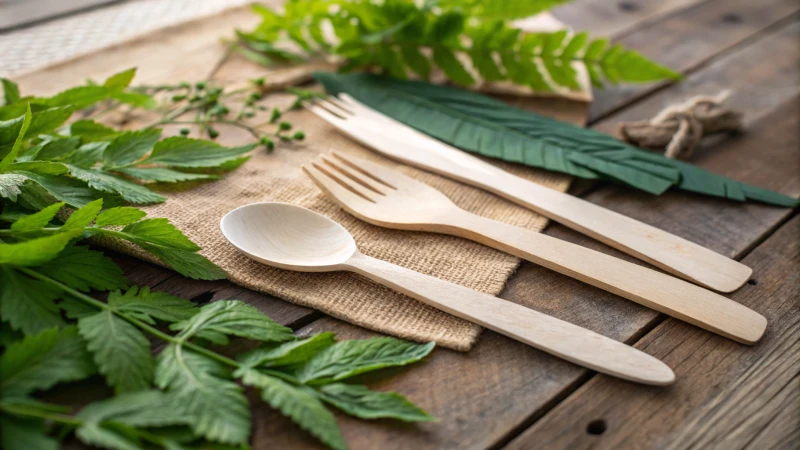
In the battle against plastic waste, eco-friendly choices like wooden cutlery are a game-changer. Join me in exploring why these natural alternatives are worth every bit of attention.
To educate consumers on the eco-friendly benefits of disposable wooden cutlery, we can use marketing campaigns that highlight its biodegradability, renewable sourcing, and its lower environmental impact compared to plastics.
I remember the first time I swapped plastic forks for wooden ones at a family picnic. It felt good knowing I was making a small, yet significant change for the planet. By sharing personal stories like this and engaging in community events, we can drive home the message of sustainability. Let's dive deeper into how we can inspire others to make this simple switch and transform their habits for a greener future.
Disposable wooden cutlery is biodegradable.True
Wooden cutlery decomposes naturally, unlike plastics which persist in the environment.
Plastic cutlery is more eco-friendly than wooden cutlery.False
Plastic cutlery contributes to pollution, while wooden options are sustainable.
What Are the Key Environmental Benefits of Wooden Cutlery?
Ever wonder if there's a simple switch you can make to help the planet?
Wooden cutlery is a green choice because it decomposes naturally, is made from renewable resources, and supports sustainable forestry. This helps cut down on plastic waste and fosters a healthier ecosystem.
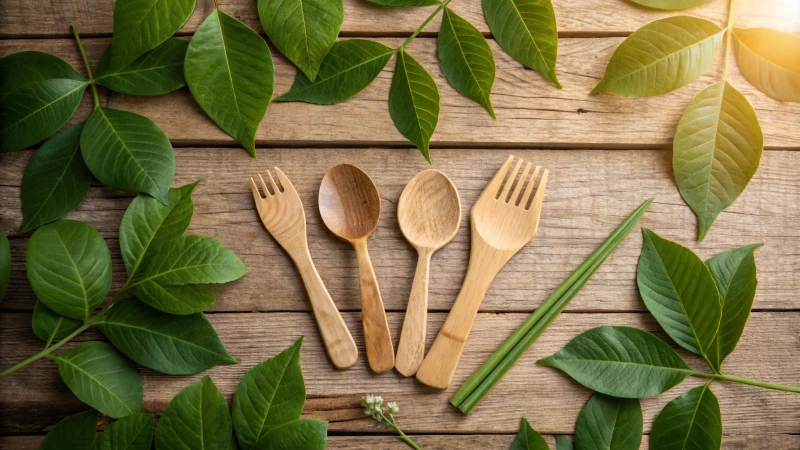
Biodegradability and Compostability
The beauty of wooden cutlery lies in its ability to biodegrade. Unlike those stubborn plastic utensils, which seem to live forever, wooden cutlery breaks down in mere months. I love that after a big family gathering, I can toss these utensils into the compost bin, knowing they'll soon be part of the earth again, not another layer in a landfill.
By selecting wooden over plastic cutlery, businesses can actively participate in waste reduction efforts1 while also promoting a sustainable lifestyle.
Renewable Resource Utilization
Wooden cutlery is crafted from fast-growing trees like birch or bamboo. These materials are sustainably harvested, so every fork or spoon feels like it's part of a larger cycle of growth and renewal. It's like my own little way of supporting biodiversity and fighting climate change. When I pick up a wooden fork certified by the Forest Stewardship Council (FSC certification2), I know I'm holding a piece of responsibly managed forest in my hand.
| Type | Plastic Cutlery | Wooden Cutlery |
|---|---|---|
| Material | Petroleum-based | Renewable wood or bamboo |
| Decomposition Time | 400+ years | 3-6 months |
| Environmental Impact | High pollution and waste | Low; biodegradable |
Sustainable Sourcing Practices
Choosing wooden cutlery from companies that prioritize sustainable sourcing is like voting for the planet with every purchase. These companies partner with suppliers who stick to ethical forestry standards, protecting natural habitats and boosting local economies. By opting for brands committed to ethical supply chains (ethical supply chain3), I feel like I'm part of a community working towards a brighter future.
Consumer Awareness and Education
Sometimes, sharing my love for wooden cutlery is as simple as having a conversation at the dinner table or during an event. Raising awareness is crucial, and it's all about helping others see how their choices can make a real difference. Educational campaigns and thoughtful marketing can nudge people towards greener options. Businesses can leverage this by weaving educational content into their strategies (consumer education strategies4). Each decision we make together creates ripples that drive change.
Wooden cutlery decomposes faster than plastic cutlery.True
Wooden cutlery decomposes in 3-6 months, while plastic takes 400+ years.
All wooden cutlery is made from non-renewable resources.False
Wooden cutlery is made from renewable resources like birch or bamboo.
How Does Sustainable Sourcing Enhance the Appeal of Wooden Utensils?
Ever wondered why wooden utensils have become the darlings of eco-conscious consumers? It's not just about their rustic charm; there's a deeper, greener story behind them.
Sustainable sourcing elevates wooden utensils by ensuring eco-friendly harvesting, minimizing carbon footprints, and promoting biodegradability. These practices connect with eco-aware consumers, boosting the product's appeal and aligning with sustainability trends.
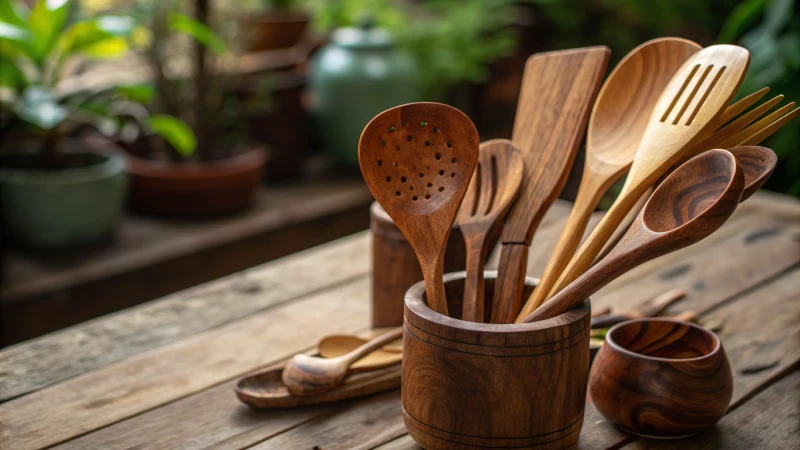
The Environmental Benefits of Sustainable Sourcing
Have you ever held a beautifully crafted wooden spoon and thought about where it came from? I did, especially when I learned that sustainable sourcing ensures the wood for these utensils comes from responsibly managed forests. This means we're not just preserving trees but also the wildlife that calls those forests home. I remember visiting a forest management site and feeling the weight of each decision to cut or conserve. Wooden utensils, unlike plastic ones that clog our landfills, are a small step towards maintaining biodiversity and reducing deforestation—they're biodegradable and can even find new life as compost.
| Factor | Wooden Utensils | Plastic Utensils |
|---|---|---|
| Biodegradability | Yes | No |
| Renewable | Yes | No |
| Eco-Friendly | Highly | Low |
Consumer Awareness and Preferences
I’ve noticed a shift in how we, as consumers, make decisions. We're more aware of our environmental impact than ever before. It’s like when my friend Sarah switched from plastic to wooden cutlery5 for her restaurant chain—she wanted to align with her customers' eco-values. Wooden utensils sourced sustainably are a natural choice for many who want their purchases to reflect their principles. I find that products marketed as sustainable often carry an air of prestige and conscientiousness that positively influences buying decisions.
Impact on Branding and Marketing
Brands today have this incredible opportunity to stand out by going green. I think back to when WonBon started emphasizing our eco-friendly practices—it transformed our brand image. Highlighting our commitment to sustainability didn't just attract a loyal customer base; it built trust. Companies like WonBon6 are using this trend to underscore their eco-friendly sourcing in marketing efforts.
Economic Advantages for Businesses
It's not just about saving the planet; there’s a financial upside too. I've seen firsthand how sustainable sourcing can lead to long-term cost savings by reducing waste and increasing efficiency. Businesses tapping into the demand for eco-friendly products are not only opening new markets but also fostering customer loyalty.
For any company looking to embrace these practices, understanding these multifaceted benefits is key. It helps them effectively position their products in a competitive market while contributing positively to environmental conservation efforts. Embracing such practices is more than good business sense; it’s a commitment to a greener future, appealing to both consumers and stakeholders alike.
Sustainable sourcing reduces deforestation.True
Sustainable sourcing involves responsible forest management, which minimizes deforestation.
Plastic utensils are more biodegradable than wooden ones.False
Plastic utensils are not biodegradable, unlike wooden ones, which can decompose naturally.
How Do Certifications Influence Eco-Friendly Cutlery Choices?
Ever wondered how a simple label on your wooden fork could change the world?
Certifications like FSC and ISO are essential in verifying that eco-friendly cutlery meets environmental standards, boosting credibility and consumer trust. They are vital for market access and promoting sustainable growth in the eco-conscious consumer segment.
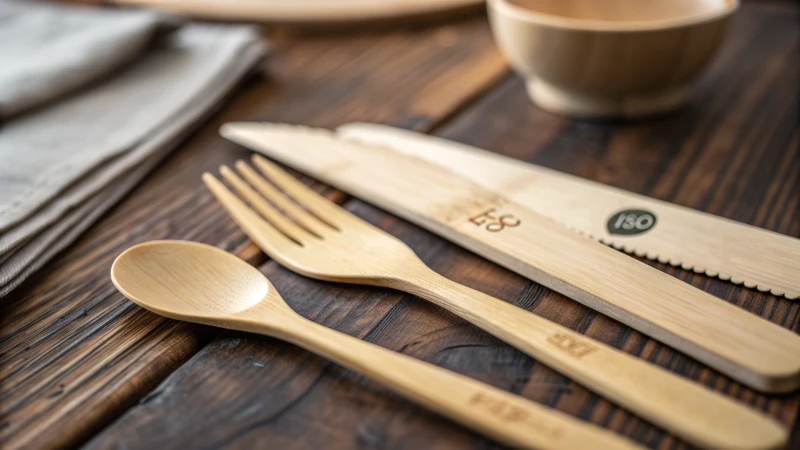
Understanding Eco-Friendly Certifications
Imagine you're at a farmer's market, searching for the perfect wooden spoon. What if I told you that little green label could be your assurance of sustainability? That's what certifications do—they give you peace of mind, ensuring the cutlery you're buying supports responsible forestry. The Forest Stewardship Council7 (FSC) certification is like a trusted friend's recommendation, verifying that the wood comes from forests that are managed with care and respect.
These certifications aren't just fancy stickers; they're a promise that rigorous standards have been met. The FSC label, for instance, symbolizes a commitment to preserving forests, honoring indigenous rights, and maintaining ethical labor practices.
The Impact on Consumer Perception
I remember when I first started paying attention to eco-labels. I was trying to make more conscious choices in my daily life and wanted reassurance that my purchases aligned with my values. Turns out, I wasn't alone. More consumers today demand transparency and accountability. Certifications act as a beacon of trust, reassuring us that our choices matter.
A recent study showed that products with recognizable certification labels saw a 20% increase in consumer preference over those without. This speaks volumes about how certifications can drive consumer behavior8 toward sustainable options.
Market Access and Business Opportunities
For businesses, having eco-friendly certifications is like holding a golden ticket to new opportunities. I've seen retailers light up when they find out a supplier is certified—it's a sign of commitment to sustainable practices. Certifications like ISO 140019 not only boost a company's image but also open doors to environmentally-focused markets.
| Certification | Focus Area | Benefits |
|---|---|---|
| FSC | Responsible Forestry | Consumer Trust |
| ISO 14001 | Environmental Management | Market Access |
| Green Seal | Product Lifecycle | Competitive Advantage |
Securing relevant certifications helps businesses stand out in crowded markets, especially in eco-friendly retail10, where customers often pay extra for verified sustainable products.
Challenges and Considerations
Of course, it's not all smooth sailing. Getting these certifications can be demanding. Companies face complex regulations and rigorous audits. But from my experience, the long-term benefits usually outweigh the initial hurdles.
If you're considering certification, a cost-benefit analysis is crucial. While the upfront investment can be hefty, the potential for increased market share and stronger consumer loyalty makes it worthwhile. This aligns with broader trends in sustainability and corporate responsibility11.
FSC certification guarantees wood is from managed forests.True
The FSC label ensures responsible forestry, confirming sustainable sourcing.
ISO 14001 certification focuses on product lifecycle analysis.False
ISO 14001 centers on environmental management, not product lifecycle.
How can businesses effectively market wooden cutlery to consumers?
I remember the first time I switched from plastic to wooden cutlery—it felt like a small step towards a big change.
To market wooden cutlery effectively, I focus on highlighting its eco-friendly benefits, like biodegradability and sustainable sourcing. By sharing compelling stories and using visually appealing packaging, I aim to connect with eco-conscious consumers and meet the growing demand for green products.
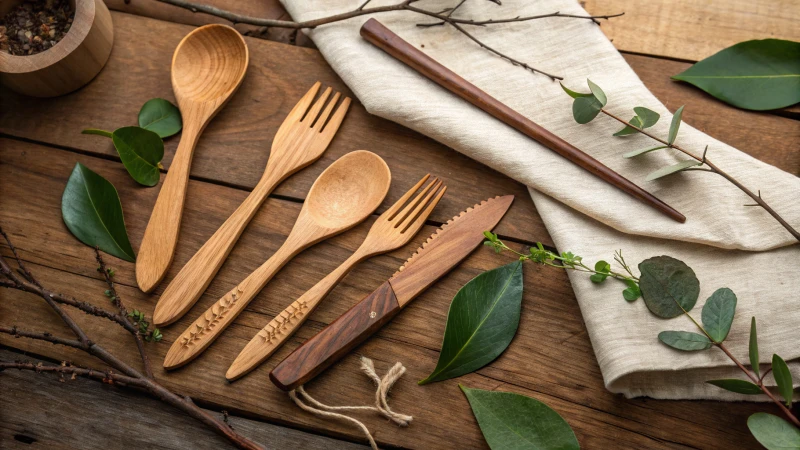
Emphasize Eco-Friendly Benefits
The first time I held a wooden fork instead of plastic, it felt like a commitment to something larger than myself—a promise to tread lightly on our planet. This is exactly what I want others to feel when they choose our products. By emphasizing the biodegradability and renewability of our cutlery, I tap into this shared desire for sustainability. Through compelling storytelling12, I showcase how each piece of cutlery aligns with the ecological values that resonate with so many of us.
Sustainable Sourcing and Transparency
I believe in the power of transparency. When I tell customers about our sustainable harvesting practices, it's more than just sharing information—it's building trust. By openly comparing the carbon footprint13 of wooden versus plastic cutlery, I make it easy for people to see why switching matters.
| Feature | Wooden Cutlery | Plastic Cutlery |
|---|---|---|
| Biodegradable | Yes | No |
| Renewable | Yes | No |
| Carbon Footprint | Low | High |
Engage Through Storytelling
There's magic in a story. When I share the journey of our cutlery from forest to table, it humanizes our brand and creates a connection with customers who care about ethical consumption. I love crafting short videos or infographics that depict this process, bringing our mission to life visually.
Visual Appeal and Packaging
Never underestimate the power of aesthetics. I ensure that our wooden cutlery is not only functional but also a delight to look at. The packaging is another story—one that reflects our commitment to sustainability. Use eco-friendly packaging14 as an additional selling point; it's not just practical but also a statement in itself.
Targeting Different Consumer Segments
Understanding my audience is crucial. Whether I'm speaking to restaurant owners or e-commerce retailers, I tailor my messages to what matters most to them—be it quality, customization options, or price sensitivity.
Education and Awareness Campaigns
Educating consumers about the benefits of switching to wooden cutlery is a passion project. Through social media platforms, I share informative content like blog posts or webinars about the impact of plastic on the environment and the advantages of sustainable alternatives.
By embracing these strategies, I'm confident in positioning our wooden cutlery as the preferred choice for eco-conscious consumers. Engaging with them in meaningful ways not only boosts sales but also builds lasting brand loyalty. For more insights, exploring global market trends15 can reveal the rise in eco-friendly dining solutions.
Wooden cutlery is biodegradable and renewable.True
Wooden cutlery is made from natural materials, making it both biodegradable and renewable.
Plastic cutlery has a lower carbon footprint than wooden.False
Plastic cutlery typically has a higher carbon footprint due to its production and disposal processes.
Conclusion
Educating consumers on the eco-friendly benefits of disposable wooden cutlery can promote sustainability, highlighting its biodegradability, renewable sourcing, and lower environmental impact compared to plastic alternatives.
-
Explore how wooden cutlery contributes to waste reduction through its biodegradability and compostability. ↩
-
Understand the significance of FSC certification in ensuring sustainable and ethical wood sourcing. ↩
-
Learn about ethical practices in wood sourcing that support sustainability and community development. ↩
-
Discover effective strategies to educate consumers about eco-friendly products and their benefits. ↩
-
Learn about the advantages of using biodegradable wooden utensils over plastic ones for reducing landfill waste. ↩
-
Explore how WonBon emphasizes sustainability in its wooden cutlery offerings to enhance brand image and appeal. ↩
-
Explains how FSC certification ensures sustainable sourcing of wooden cutlery, helping consumers make informed choices. ↩
-
Shows how certifications affect consumer preferences, highlighting the growing demand for certified eco-friendly products. ↩
-
Details how ISO 14001 can enhance business reputation and market access in sustainability-focused industries. ↩
-
Provides insights into consumer willingness to pay premiums for certified sustainable goods. ↩
-
Explores the broader advantages of sustainability certifications in enhancing corporate responsibility. ↩
-
Discover ways to craft compelling stories that resonate with environmentally-conscious consumers. ↩
-
Gain insights into how wooden cutlery has a lower environmental impact compared to plastic. ↩
-
Learn about the advantages of using sustainable packaging in enhancing brand image. ↩
-
Explore current trends driving the demand for sustainable dining products worldwide. ↩

